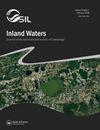Effects of inundation on water quality and invertebrates in semiarid floodplain wetlands
IF 2.3
3区 环境科学与生态学
Q1 LIMNOLOGY
引用次数: 0
Abstract
ABSTRACT Floodplain wetlands play a significant role in the storage of sediment and water and support high levels of nutrient cycling driven by intermittent inundation. In regulated rivers, the frequency and duration of floodplain inundation are often reduced. Managed water inundation is used as a tool to help restore floodplains, but its outcome on wetlands requires further quantification. We examined the effects of environmental floodplain watering on water quality and 3 groups of invertebrates, including benthic and pelagic microinvertebrates and macroinvertebrates, in 2 wetlands systems on the Gwydir River system in the north of the Murray-Darling Basin. We hypothesised that a wetland inundated for longer periods would alter water quality and support a greater richness and abundance of invertebrates, thus altering their assemblage structures. Water quality and the assemblage structure of all 3 invertebrate groups in the wetlands were significantly influenced by the time since connection (TSC) to their rivers and therefore the length of inundation. However, the response of water quality and the microinvertebrate assemblages to TSC differed between the 2 wetlands. Water quality was affected by an increase in 6 variables, including total nitrogen, and a decrease in soluble reactive phosphorus. Microinvertebrate abundance was positively associated with TSC, but the abundance of macroinvertebrates was not. The relationships demonstrated between TSC and invertebrates indicate that the duration of inundation is important for ecological structure and food webs in these and other semiarid floodplain wetlands.淹没对半干旱洪泛平原湿地水质和无脊椎动物的影响
摘要洪泛平原湿地在沉积物和水的储存方面发挥着重要作用,并支持间歇性洪水驱动的高水平营养循环。在受管制的河流中,泛滥平原淹没的频率和持续时间通常会减少。管理水淹没被用作帮助恢复洪泛平原的工具,但其对湿地的影响需要进一步量化。我们在墨累-达令盆地北部的Gwydir河系统的两个湿地系统中,研究了环境洪泛平原浇水对水质和3组无脊椎动物的影响,包括底栖和浮游微型脊椎动物和大型无脊椎动物。我们假设,长时间被淹没的湿地会改变水质,支持无脊椎动物的丰富性和丰度,从而改变它们的组合结构。湿地中所有3个无脊椎动物群落的水质和组合结构都受到连接到其河流的时间(TSC)的显著影响,因此也受到淹没长度的影响。然而,两个湿地的水质和微脊椎动物组合对TSC的反应不同。水质受到6个变量的影响,包括总氮的增加和可溶性活性磷的减少。微型无脊椎动物的丰度与TSC呈正相关,而大型无脊椎动物的丰度则不相关。TSC和无脊椎动物之间的关系表明,淹没的持续时间对这些和其他半干旱漫滩湿地的生态结构和食物网很重要。
本文章由计算机程序翻译,如有差异,请以英文原文为准。
求助全文
约1分钟内获得全文
求助全文
来源期刊

Inland Waters
LIMNOLOGY-MARINE & FRESHWATER BIOLOGY
CiteScore
6.10
自引率
9.70%
发文量
34
审稿时长
>12 weeks
期刊介绍:
Inland Waters is the peer-reviewed, scholarly outlet for original papers that advance science within the framework of the International Society of Limnology (SIL). The journal promotes understanding of inland aquatic ecosystems and their management. Subject matter parallels the content of SIL Congresses, and submissions based on presentations are encouraged.
All aspects of physical, chemical, and biological limnology are appropriate, as are papers on applied and regional limnology. The journal also aims to publish articles resulting from plenary lectures presented at SIL Congresses and occasional synthesis articles, as well as issues dedicated to a particular theme, specific water body, or aquatic ecosystem in a geographical area. Publication in the journal is not restricted to SIL members.
 求助内容:
求助内容: 应助结果提醒方式:
应助结果提醒方式:


